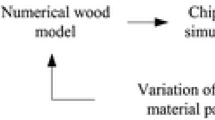Abstract
The general aim of work reported here was to assist designers and operators of routers and similar tools for cutting wood-composite boards, by providing a model predicting cutting force components from readily available material properties. This initial study explored, for edge cutting, the variation within a single medium density fibre board across the thickness and in various cutting directions in the plane of the board. Material properties of interest were specific gravity and friction coefficient. In slow linear cutting on a modified milling machine, carbide router inserts cut the edges of layers cut from a medium density fibre board. Specific gravity and coefficient of sliding friction were measured for each layer. Cuts were also made on full-thickness edges in various directions in the plane of the board. Chip thickness was varied from 0.025 to 0.8 mm. Parallel and normal force data and digital video images of chip formation were stored for analysis. Specific gravity increased as the fourth power of the distance from the central plane to the surface. Friction coefficient values, estimated both from cutting forces and from rubbing forces during return, varied about a value of 0.23, with no significant difference between layers. The values for cutting force per mm width of cut increased progressively from the central plane to the surface, in a logarithmic relation with specific gravity. The cutting forces did not vary with cutting direction in the plane of the board. For a sharp edge with 32° rake angle cutting at chip thickness values above 0.1 mm, the normal force component was negative, indicating reduced feed force and improved surface quality. With dulling, the threshold value of chip thickness for this increased. It is concluded that elaboration of this approach would generate relationships suitable for incorporating in a useful general model. However, it may be found that weight per unit area of board will suffice as a proxy for cutting resistance in modelling the cutting of full-thickness edges.
Similar content being viewed by others
Author information
Authors and Affiliations
Additional information
Received 10 June 1999
Rights and permissions
About this article
Cite this article
Mckenzie, W., Ko, P., Cvitkovic, R. et al. Towards a model predicting cutting forces and surface quality in routing layered boards . Wood Science and Technology 35, 563–569 (2001). https://doi.org/10.1007/s002260100115
Issue Date:
DOI: https://doi.org/10.1007/s002260100115




